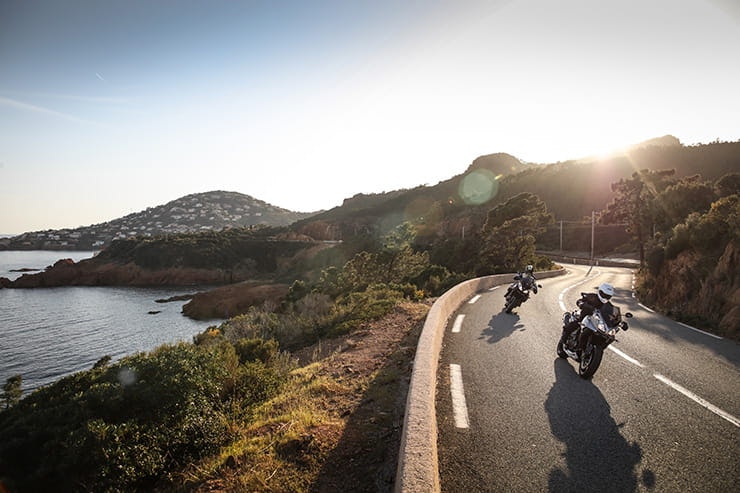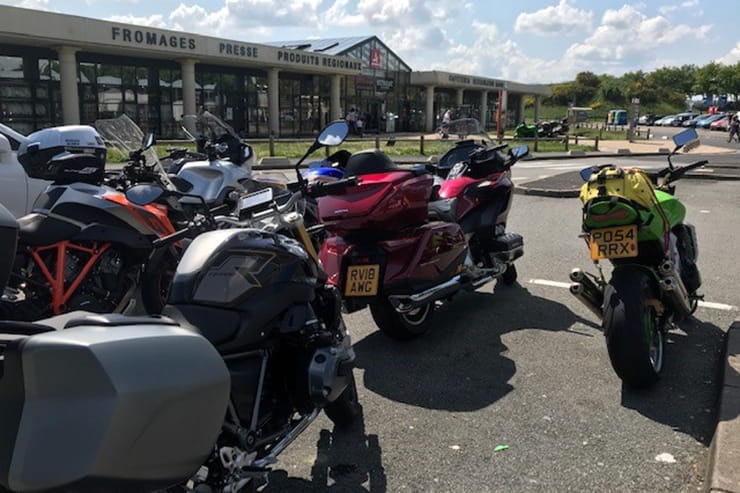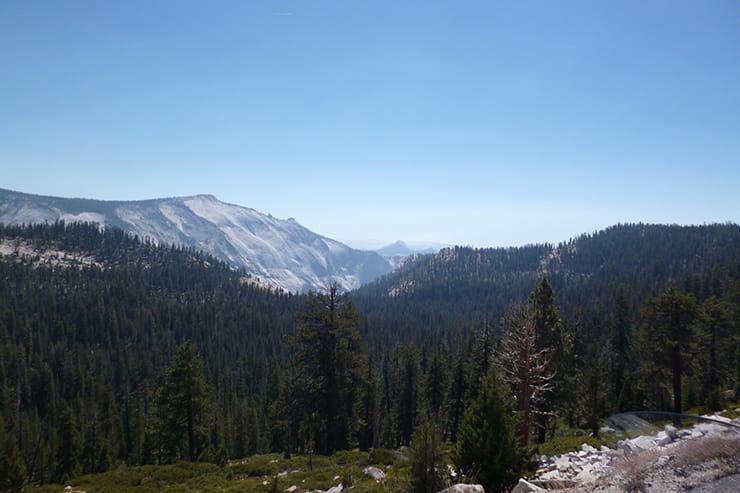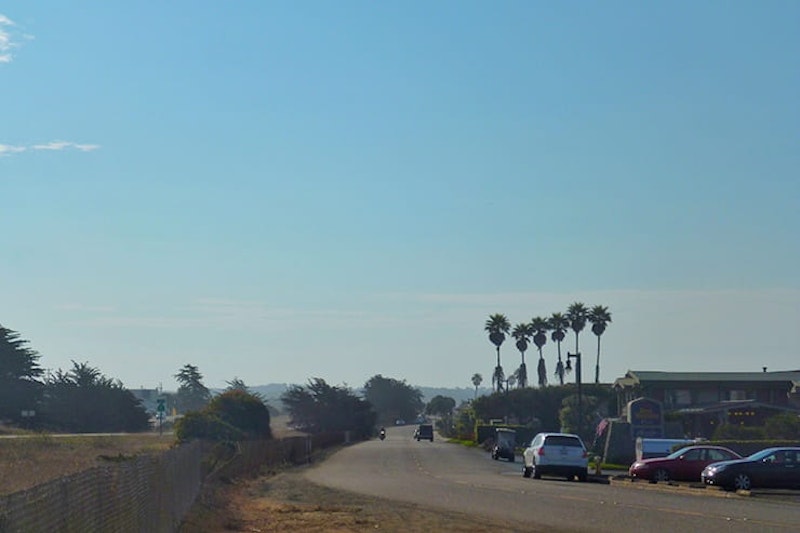Expert advice on motorcycle touring. Where to go, what to pack, how to ride abroad and what to do if it all goes wrong
By Steve Rose
BikeSocial Publisher
18.02.2019
There is no better way to travel than by bike. Here are BikeSocial’s 12 simple tips to make motorcycle touring easy.
Seeing the world by motorcycle is like seeing the world in technicolour
1. Tour or adventure?
The rules are straightforward; travel light, have a plan but don’t be too rigid about sticking to it. Some bright spark once described adventure as being ‘A trip without a plan, because it wouldn’t be an adventure if you knew what was going to happen’. Someone else said ‘Tourists don’t always know where they’ve been, travellers don’t know where they are going.’ If those sentiments float your boat, then you’ll understand why planning is important, but only because it gets you to the ferry port on time.
This tyre still has 2000 miles of tread left, but has already squared off affecting the bike’s handling
2. Make sure your bike is up to it.
A puncture on the autobahn or running out of brakes halfway down an alp is a disaster, not an adventure. Check that your bike is ready for a long trip. When was it last serviced? Be aware that a few thousand miles will have a serious impact on things like tyres, drive-chain and brake pads, so they all need to be in good order before you leave. Don’t forget that even if your tyres still have plenty of tread, a few hundred motorway miles could square-off the edges which will affect the handling when you reach those Alpine hairpins.
Before you go, take the time also to sort the niggling faults like loose mirrors, badly-taped wiring and the gear lever that needs moving up a notch on the mounting.
Use the space for your bike’s tool kit to take some decent quality, carefully selected tools
3. What do you need to take for motorcycle touring?
You’ll need to take your bike’s V5 document, insurance certificate, driving licence, passport and breakdown cover. Make sure they are in a pocket in your jacket and not one of the items that falls out of the hole when your throw-over pannier catches fire on the exhaust. Plus we’d recommend a European health insurance card (EHIC) as a minimum requirement, but ideally, you’ll have some motorcycle-specific travel insurance too.
If your Japanese bike still has its original tool kit, find a bin, remove the items from the pouch and throw them in it. Replace them in the pouch with some good quality spanners, allen keys and screwdrivers in the sizes you’ll need to adjust the chain, remove a rear wheel and work on the majority of fasteners on your bike. Choose carefully and you won’t need a lot of room. Or alternatively, you can buy aftermarket tool kits of much better quality than most factory items. Don’t forget a tubeless tyre puncture repair kit and bookmark some videos on how to use it.
In some European countries you have to carry a reflective vest to wear if your break down and in France there’s a requirement to wear gloves on a motorcycle and to carry a disposable breathalyser (but currently, no punishment for not carrying one).
Neither a full tourer or a sports bike, BMW’s R1200R is fast, nimble, comfy and pillion friendly
4. The right bike for motorcycle touring
The best touring bikes have a comfy seat, a riding position that isn’t too tilted forward or cramped, but also not too upright either. Many big adventure bikes have very upright positions which can put too much weight on the small of your back and be surprisingly uncomfortable after a couple of hours.
A 200-mile fuel range is handy because rural fuel stations aren’t always plentiful or open when you need them. Built in hard luggage is more dependable and watertight than soft luggage, but adds weight and bulk and makes getting your pillion work harder to get on and off. Talking of pillions, a proper seat and decent grab rails in addition to a top box for a back rest will keep everyone happy and a quickshifter on the gearbox will stop the headbanging.
The trouble is a proper touring bike costs well in excess of £15,000, weighs as much as a small horse and is rarely the sportiest thing for tackling 108 continuous hairpin bends on a Swiss mountain pass. Thankfully you can tour on anything. Some people cross Europe on mopeds, others use a 180bhp sports bike. It really doesn’t matter so long as you have either the patience and time to go slowly or the fitness to curl yourself into a sporting ball for day after day, while wearing a heavy rucksack.
There are things you can do to almost any bike to make it more suitable for touring; tank bags give sports bike riders something to lean on, Ventura luggage racks allow extra carrying capacity (and a pillion backrest) on inappropriate bikes, adjustable handlebars, taller screens and Bluetooth intercoms will all make life easier. The one thing you can’t change easily is fuel range, so work out your route, get yourself an up-to-date app listing fuel stations in the country you’re visiting and check your credit cards work at the first opportunity.
Getting to the best bits can be half the fun, or (literally) a pain in the backside. Or neither if you let someone else transport your bike.
5. Pick the right route on a motorcycle tour
While the bumpy back roads of rural Italy or a couple of laps of Barcelona are glorious on a scooter, they’re not so good on a Ducati 1098. It’s tempting to pick the twistiest, most scenic route and avoid motorways at all costs. And that’s fine if you have plenty of time to get there. Going the scenic route means you’ll struggle to top 300 miles in a day, will get lost…a lot and have less time at your destination. But you will see a lot more and have many more adventures. Hitting the motorways can be expensive (most in Europe are toll roads) and very boring, but effective too.
Two smart alternatives to this are to fly south and then hire a bike when you’re there, allowing you to miss out on the motorway slog across Europe and save on wear and tear on your tyres and chain. Or alternatively use a service like Bikeshuttle, which transports your bike to Europe, where you fly in and collect it and then back home again at the end of the trip.
Two weeks’ of everything on two bikes. Not pretty, but very effective.
6. Packing for motorcycle touring
The best way to pack light is wear as much as you can. Jeans under your textile trousers, long sleeve t-shirt over short sleeve t-shirt, with another short sleever as your top layer. Socks, pants, a couple of spare t shirts, a going out shirt and a pair of shoes in your bag along with toothbrush and paste, deodorant, plus 3-in-one shampoo, conditioner and body wash. Leave some room for your camera and phone charger and that should be it. Wash what you can on the way and if things get tough find a supermarket and buy things as you need them.
Make sure you have basic tools for adjusting the chain, a small can of chain lube, tubeless tyre repair kit and a decent disc lock under the seat (because bike theft is as bad in Europe as the UK).
Ideally put your stuff in a tailpack (if travelling solo) tank bag (if there’s two of you) and add a decent, not too big, but waterproof rucksack if you need more.
Throwover panniers seem like a great idea but need careful fitting and moderate loading or they sag onto exhaust pipes and catch fire leaving a trail of blazing underpants lighting up the autobahn like elasticated Chinese lanterns.
Hard luggage is great if you can afford it and much more secure on the bike, but it adds width and bulk and can cause instability on some bikes at high speed.
Every eventuality covered? It doesn’t have to be difficult.
7. Motorcycle holiday travel insurance
Check that your regular bike insurance covers your bike should you have an accident abroad. Assuming that it does, then you’ll still need to find the right cover for medical emergencies, lost possessions or cancelled ferries etc, which can be harder than you’d think for holidays involving a motorcycle. In Europe you’ll get basic medical cover through your EHIC card (at least until Brexit, no one is quite sure what happens after that), but in other regions you’ll need proper insurance you can trust. Put ‘Motorcycle travel insurance’ into a comparison site and you’ll find plenty of options, but check the small print carefully – very few of them actually mention motorcycles. BikeSocial’s parent company, Bennetts has a travel insurance product designed for motorcyclists that also includes cover for track days too.
Roll on, roll off, only a small hangover
8. Taking a motorcycle on a ferry
Ferries on bikes are easy. Normally motorcycles are the first vehicles on and first off at the other end too. Also, because we take up so little room, arriving early or late is less of a problem because they can often squeeze us onto an otherwise full boat.
There are just two things to be wary of. Firstly, the steel ramps can be slippery when wet, so be careful as you ride on and (especially) off the ferry. Smoothness is the key; be gentle with the throttle, get the clutch fully out and ride smoothly up the ramp. When coming down a wet ramp, get the bike moving on the level, with clutch out in first gear, no throttle, give yourself some space to the bike in front and let the engine braking manage your speed.
The other thing to be aware of is that you may be left to strap your bike down yourself. There will be staff around to help and if you aren’t sure, ask for assistance.
To strap your bike down, put it on the side stand and leave it in gear. Try and use at least two tie down straps - one going over the saddle (put a rag under the strap to prevent damage) and another from the pillion footpeg hanger on the side stand side to the floor.
Cabins are expensive but on a longer trip you’ll be glad of somewhere to dump your kit and freshen up.
Filling up with fuel before you get on the ferry port means you don’t have to stop half an hour after disembarking. Not filling up gives you a reason to stop after half an hour to check everything is still in place. You choose.
You’ll see more police cars in Texas than most small UK towns. Mostly foreign coppers are friendly, but lack a sense of humour so try and return the favour
9. Riding abroad
European motorways are superb but are mostly toll roads. Some are paid as you go, others need a prepaid vignette. Traffic is usually lighter than UK motorways, more polite and there are plenty of fuel stations. But French police are tough on speeding and it’s common to find a speed trap not too far from Calais. On the spot fines are strictly enforced with a lift to the nearest cashpoint if needed. Fines from a speed camera will follow you home and ignoring them will prove massively expensive next time you go abroad (you might even be refused entry until paid).
Once on the minor roads you’ll hardly ever see a copper though and if you do, many of them are bike friendly. European drivers are much more bike aware because most of them grew up on mopeds.
America has a lot of police for such an enormous country. Mostly, they leave you alone and are friendly, but they take they job seriously when needed.
Getting to L.A. is easy. Finding your hotel takes cunning
10. Finding your way
Finding a sign that says ‘Milan’ is easy. Finding one that says ‘your hotel this way’ is unlikely. Which means you can use maps and a list of towns and roads to look out for to get you close and then turn on the sat nav for the last few miles.
Motorcycle sat navs are designed to be vibration and water resistant plus easy to operate in thick gloves. They tend to be more expensive than car units so many riders use the one they bought for the car but only switch it on for the last ten minutes of a journey to save on battery use.
Without sat nav, things are harder, but not impossible. Getting to the outskirts of major towns is simple in Europe - make a list of the major towns en route and follow the signs for them. After that, head for the nearest recognisable landmark, stop for a coffee and use your maps app on your phone.
Not all stations take UK bank cards, so make sure you have cash too and fill up before you need to
11. Petrol
It costs a little more in most European countries because of the current poor exchange rate. Almost everywhere takes UK credit cards, but some of the stations are automatic and unmanned and they don’t always accept British cards, so fill up when you stop and always leave yourself a few miles in reserve just in case. Regular unleaded fuel is 95 RON - that’s what you need to be looking for, although most European countries now label pumps fuel according to the percentage of ethanol in it. Five per-cent Ethanol is best, but most bikes will run fine on ten per cent too.
Riding on the right is easier than driving. Remind yourself when you leave a fuel stop or café.
12. Riding on the right
Riding on the right is easier on a bike than in a car because you still have the same visibility and road positioning. The most common problem happens just after a stop. You’ve filled up with petrol, stuffed your face with vegetarian frog’s legs and forget for a moment that you are abroad and turn out of the petrol station into the left-hand lane. Bad move.
Always take a moment to think. Put a sticker on your speedo or mirror saying ‘keep right’ if it helps. And make sure at junctions also that you look the correct way for oncoming traffic.
Foreign roundabouts are easy once you get the hang of them, but in some countries priority is given to traffic coming onto the roundabout (priotie a droite). Also many French roundabouts have a strong negative camber, which helps them drain in the wet, but also makes them easy to crash on.
Making new friends is easy on a bike
13. Be friendly
Motorcyclists make friends wherever they go. No one knows why, but it happens. Strangers wave at you, help and kindness appear from nowhere and the world feels fresher and more appealing from the well-worn saddle of a bike. Embrace this warmth and be friendly, talkative and open in return.



